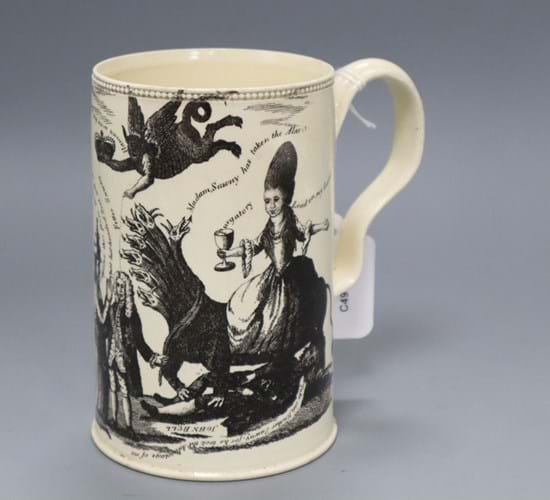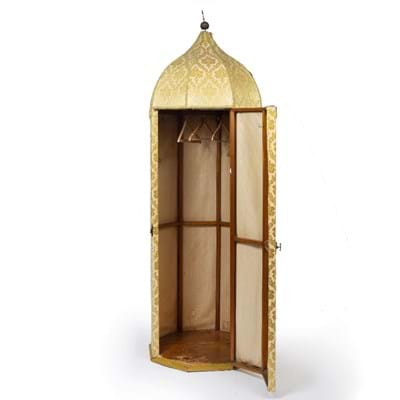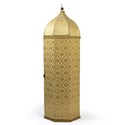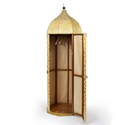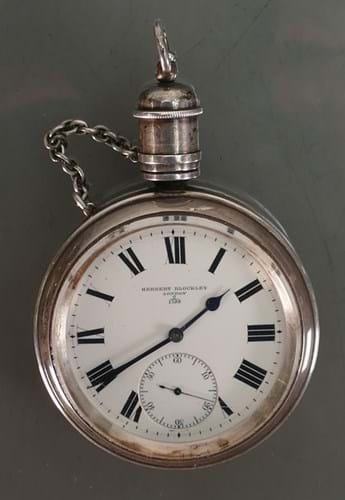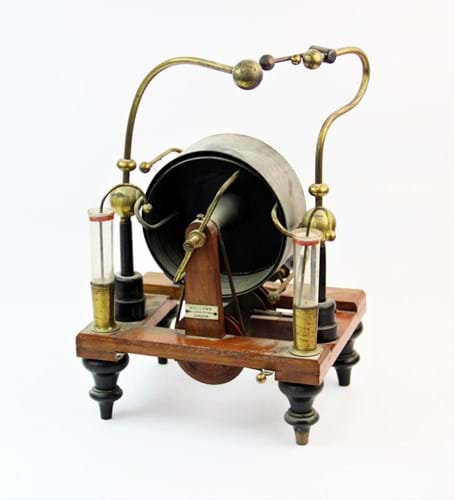1. Robinson & Sons campaign wardrobe – £3400
This deluxe Victorian travel accessory is a ‘campaign wardrobe’ made by Robinson & Sons of Ilkley, Yorkshire. Fashioned in a gold floral upholstery around an octagonal pine and mahogany frame, it was really made for the domestic market rather than for international travel.
The interior is fitted with brass hooks and an enamel label reading Patent, Patentees and Manufacturers, Robinson & Sons Ilkley, Yorkshire. The firm was known primarily for their Ilkley Portable Couch, a campaign day bed which proved so popular it was copied by a number of other companies.
This wardrobe also proved influential later in life: the example owned by designer Nicky Hallam was the inspiration for a wardrobe he recently designed for retailers OKA.
This late 19th century original, last sold at Christie’s in London in January 2014 for £2800, reappeared for sale at the Mallams House & Garden sale in Abingdon on March 17 with an estimate of £600-800. It again proved popular selling at £3400.
2. ‘Explorers’ pocket watch – £2800
This unusual silver pocket watch by Herbert Blockley of London sold for an unexpected £2800 (estimate £200-300) at Potteries Auctions in Stoke-On-Trent, March 14. A clue to its origins is the screw-off cap to the winder.
Timekeepers such as this, with heavy duty waterproof cases, are known as the Royal Geographical Society pattern ‘explorers’ watch. Made from the last decade of the 19th century (the case to this one is hallmarked 1899) they were supplied by the Clerkenwell watchmakers Usher & Cole to the retailer Herbert Blockley of 41 Duke Street, St James. Many were sold to the Royal Geographical Society and to private clients.
3. 18th century creamware mug – £1500
This rare English creamware mug, sold for a multi-estimate sum at a Gorringe’s weekly sale on March 16, tells of the hysteria that greeted the Catholic Relief Act of 1778.
The so-called Papists Act allowed Roman Catholics to join the army and purchase land if they took an oath of allegiance.
The transfer printed scene is a simplified version of an anonymous print titled Sawneys Defence against the Beasts, Whore Pope and Devil that first began to circulate in February 1779.
To the left of the composition stands a Scottish soldier in Highland dress who cries ‘Be Gone Judas’ alongside clerics who cry ‘No Faith Kept with Hereticks’.
Meanwhile across the River Tweed the forces of Popery are triumphant. John Bull lies prostrate on his back, trampled underfoot by the Whore of Babylon riding the seven-headed Beast of Rome, while nearby the Pope addresses the king saying: ‘I Absolve Thee From The Breach of Thy Oath’.
The guide on this rare 6in (15cm) mug, that was in great condition save a minor chip to the foot, was £80-120. However, bidding reached £1500.
4. Victorian electrostatic generator – £2400
The Wimshurst influence machine, an electrostatic generator capable of creating high voltages, was developed between 1880 and 1883 by British inventor James Wimshurst (1832–1903).
This example, of typical composition with two contra-rotating cylinders, two Leyden jars and a hand crack mechanism, has a label for the London optical and scientific instrument maker Dollond and Company of Ludgate Hill. It stands 17in (42cm) high on a hardwood base.
Offered for sale at Trevanian & Dean in Whitchurch, Shropshire, on March 14, it took £2400.


